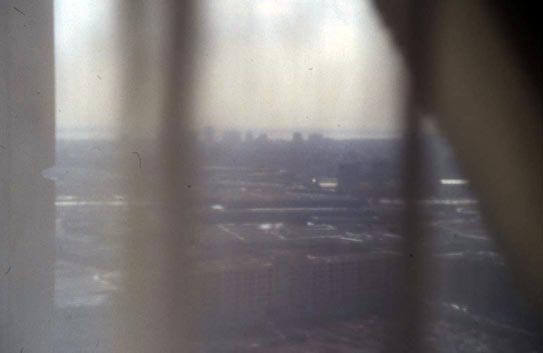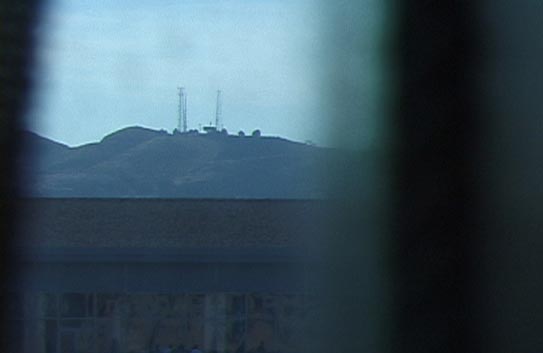







Medium:
Video walk
Duration:
15 minutes, 20 seconds
Commissioner:
Curated by John S. Weber together with Aaron Betsky, Janet Bishop, Kathleen Forde, Adrienne Gagnon, and Benjamin Weil for the group exhibition, 010101: Art in Technological Times.
Janet Cardiff
| This is the only time I’ve produced a second piece for a museum. The first one, the audio walk from 1997, used the structure of the building as a memory map. This one, a video walk, created a narrative that involved interactions with people in the space, but still used the architecture as a baseline. The basis of the narrative was about how our minds invent scenarios from chance meetings between people. The piece was largely about self-induced anxieties and how the fears we have change our perception of our world.
hear woman in front of you talking about her fear of frogs. I can’t go into Chinatown even in case I see a store selling frog legs … Janet Batrachophobia … Frogs in my soup. Frogs in my bed, crawling up my legs. Frogs falling from the sky … What am I afraid of ? the audio shifts to scary music as I say these things image shifts to an apartment, walking down a hallway. look through doorway and see a woman in a black slip on the bed. sound of cell phone rings beside you. sound of getting telephone out of bag. visuals go back to that of museum in front of you Janet Hello, Bernard What are you thinking about ? Janet Who is this ? Bernard What do you mean ? I’m sitting right beside you. Janet We have to go now. Point the camera where I’m pointing it. Synchronize your movements with mine. Stand up. Walk to the right. Follow this woman. Go behind the stairs. Now walk past her. |
|
| Janet Cardiff ’s video walk, The Telephone Call, opened at the San Francisco Museum of Modern Art on March 1, 2001, as part of 010101, Art in Technological Times, an exhibition about the intersection of art and new technologies. The piece leads visitors through the museum on a meandering tour up the central staircase, taking them briefly into a nearby gallery, and then into a service stair normally off limits to visitors. Cardiff ’s voice muses on the people she is seeing and the overheard conversations and encounters around her. Layers of real and recorded sound overlap, creating a rich and ambiguous sense of space. A man calls. In the bleak service stairwell, the tour pauses and the camera goes black. Ominous footsteps approach from behind in the stairwell. Alone and convinced they’re in the wrong place, visitors wait, hearts racing. As one visitor put it, “I thought someone was going to kill me on the stairs. Brilliant.” The walk concludes with a stroll over the fifth floor bridge high above the museum’s atrium, closing with a view out to the west hills of San Francisco.
To someone who hasn’t taken one, it is impossible to explain the bizarrely intense sensation of psychological immersion created by Cardiff ’s video walks. They engender a sense of trance-like disorientation that is unlike anything else in contemporary art, and not remotely comparable to the experience of cinema. In an unpublished video interview done while Cardiff was working on the piece at SFMOMA, she compared her audio and video walks, noting that audio has “this way of fluidly moving and entering the person’s body in a subversive way.” The video walks possess that quality, too, but in video walks, “the world becomes this weird, amorphous thing that’s not really there… it’s like an alternate reality, like you’re going into a different dimension. I was surprised at how much it puts you into a trance afterward. The reason is that your brain is concentrating so much on trying to line up the reality that is the video image with the reality that’s outside.” At the same time, she pitches her voice in a very particular way, “like a thinking voice, like it is going right into your brain, and I think that way of speaking is very hypnotic.” Carefully following the image around the museum, listening to Cardiff ’s voice, people are suspended between Janet’s invented world and the real world. When the invented world suddenly stops, it’s disconcerting, and more than a bit strange. Cardiff closed The Telephone Call by saying, “Goodbye.” In that moment it felt like you’d just been kicked out of her brain, or that she’d left yours after a brief but exquisite mind-meld that the artist describes as “a bit of a merging of two people.” The tour created a sense of human connection that was palpable, and in its wake came feelings of abandonment, fascination, and intense gratitude. Visitors also frequently described a sense of pleasant insecurity as to whether the piece was in fact really over when the video stopped. They described thinking and hoping that everyone around them – who had, of course, just been absorbed into Cardiff ’s theater – might still have lines to speak and roles to play. In nearly two decades of curating, I have never seen anything like the kind of intoxicated audience response The Telephone Call generated. There are a number of things one could talk about here beyond the sheer level of enthusiasm for The Telephone Call, but what I want to single out briefly is the unusual intimacy it establishes. Again and again, people who took The Telephone Call at SFMOMA described their experience in virtually sexual terms: a mingling of bodies; the feeling of being “in” someone and having someone inside them; a sense of unusually close psychological and physical communion with another person. A number of visitors observed that they needed to cry in the elevator after finishing the piece. Needless to say, these are not the terms in which people normally describe their experiences of visual art. Yet in another sense, Cardiff ’s work succeeds precisely in doing what much art claims to offer but fails to deliver: a view into another’s brain and body – a way to see, hear, and seemingly feel (through the motion of the body in space) another person’s reality. That Cardiff achieves this through the highly mediated experience of recorded audio and a tiny video image makes the user’s experience all the more unexpected and therefore psychologically overwhelming. John Weber |